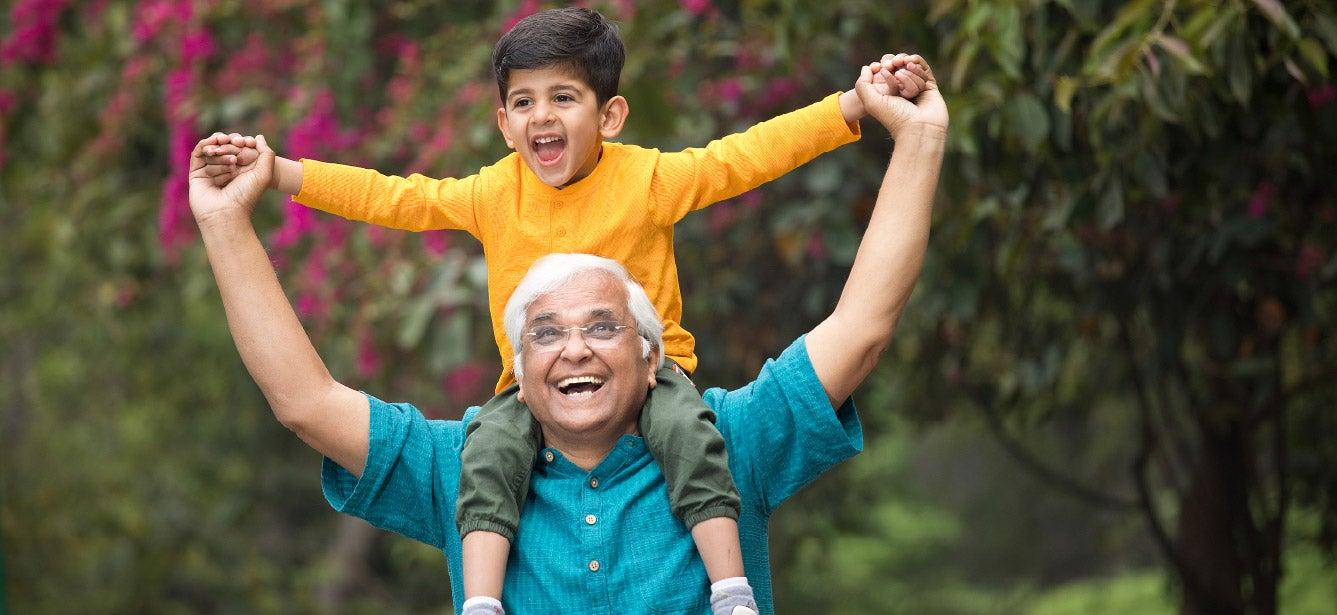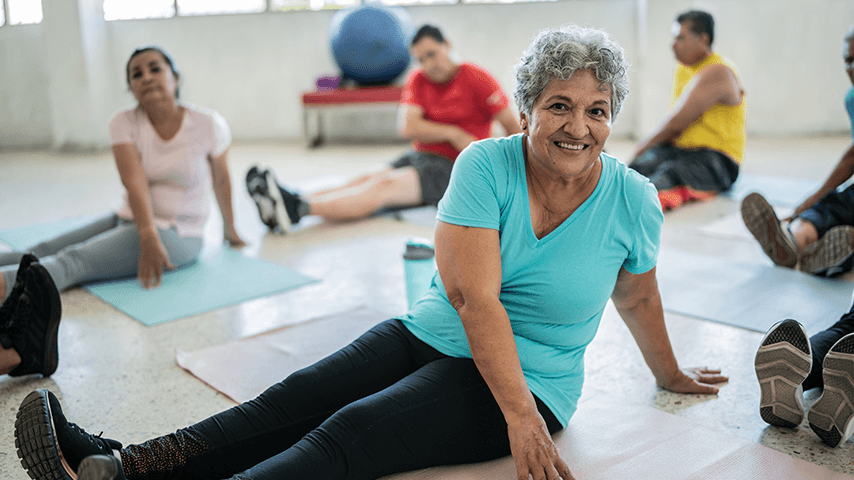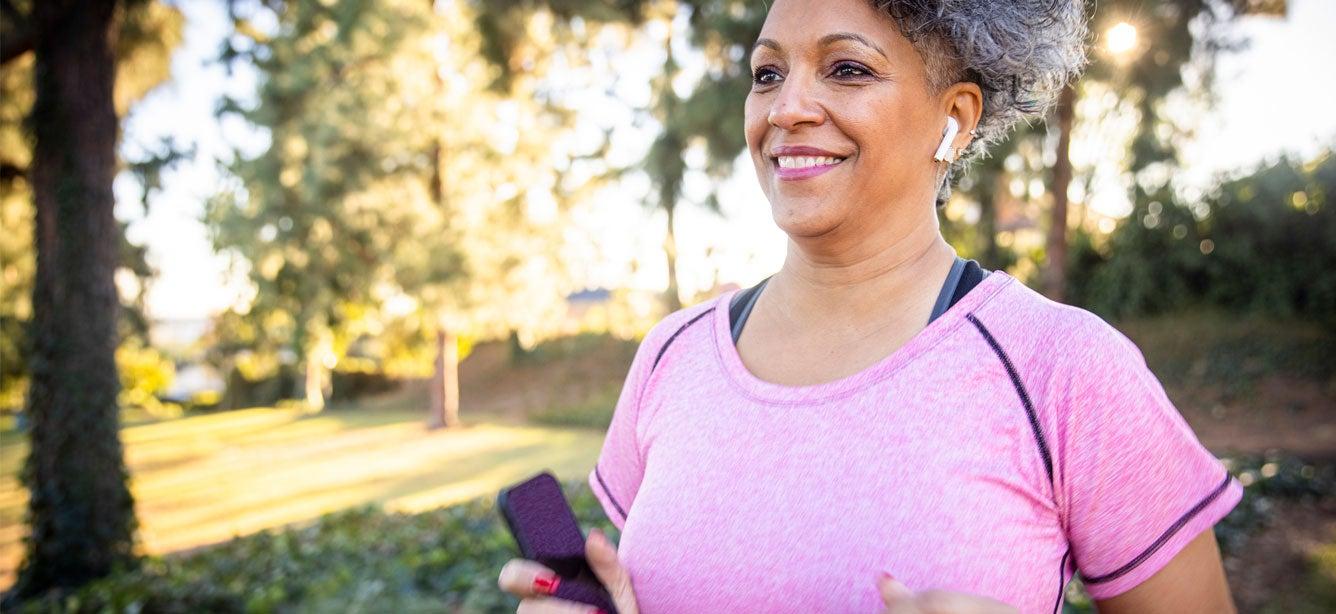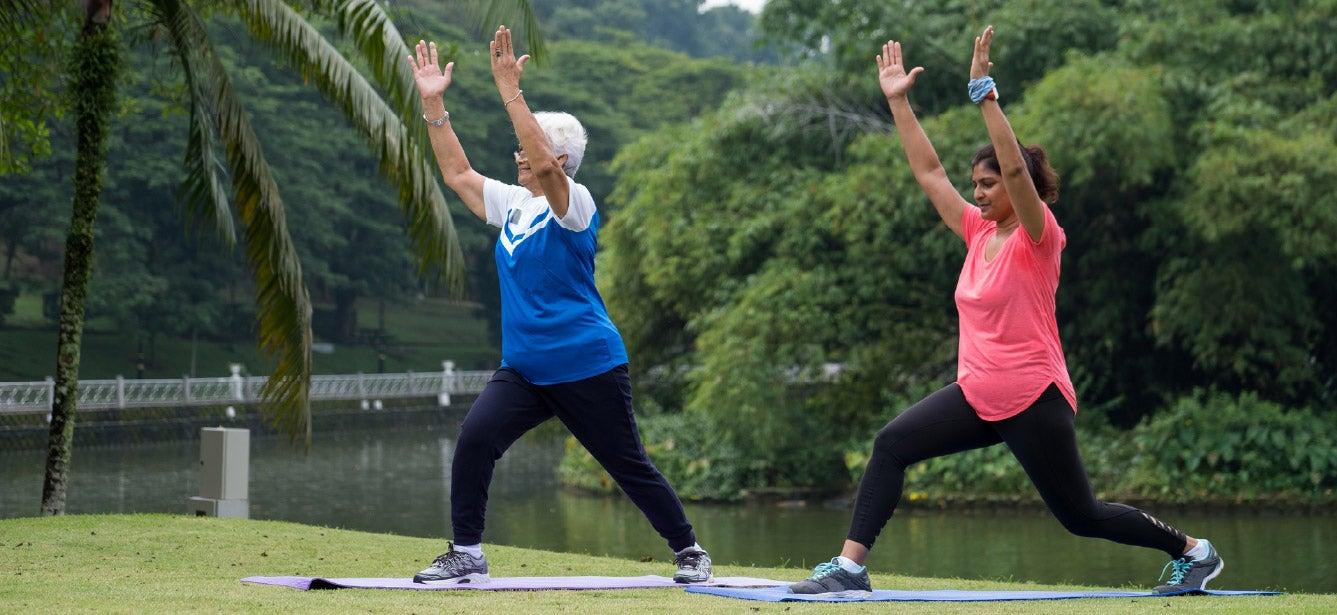
Related Topics
Chances are, you’ve heard someone say use it or lose it—a timeless phrase that broadly applies to many things in life: The milk in your refrigerator. Money in a flexible spending account. Your brain. Your physical fitness.
Speaking of physical fitness: Because these four words are so often associated with staying in shape, you also likely know how much fitness matters—and that it doesn’t just happen on its own. In order to keep your heart, lungs, muscles, and bones functioning well, you need to exercise them nearly every day. Otherwise, like the milk you forgot about in the back of the fridge, they can deteriorate over time.
“The evidence is clear: getting enough exercise, and the right kinds of exercise, can keep you stronger and healthier as you age,” said Susan Stiles, PhD, Former Senior Director of Healthy Aging at NCOA. “But if you live with osteoarthritis or other conditions that cause chronic pain, exercise isn’t simply a matter of rallying yourself off the couch and signing up for a fitness class.”
In other words, mind over matter doesn’t work when your knees hurt, your hips ache, or your back is stiff.
The benefits of staying fit with age-related pain
Still, Stiles cautioned, you shouldn’t use pain as a free pass to avoid exercising altogether.
Leia Rispoli, MD, a double-board-certified interventional pain management specialist and physiatrist, agrees.
“From a physical perspective, enjoying an appropriate exercise routine is beneficial in so many different ways, especially as we age,” Rispoli explained. “As long as the exercise isn't posing an excessive risk of injury, it can provide cardiovascular maintenance, good musculoskeletal and bone health, and in some respects, provide injury prevention."
Stronger muscles and consistent mobility support aging joints and bones. Exercise [also] boosts endorphins, which can help relieve pain, reduce stress, and improve mood,” Rispoli said.
Even if your mobility is limited by degenerative joint disease—or if you haven’t exercised in a while for other reasons—you can safely rebuild a conditioning routine.
Why you should create a conditioning exercise routine
1. To maintain your independence
It’s easy to take the activities of daily living for granted. That’s why it’s important to understand that many of them depend on having enough strength, flexibility, and balance to do them safely, and for many years. Lifting a bag of groceries, getting into and out of the car, mowing the lawn, walking the dog, and opening a jar of pickles each requires mobility and coordination. When it comes to living in your own home on your own terms, the time you devote to exercise is time well spent.
Exercise is important for several reasons, says Andrew Walker, director of Health and Well-Being for the National Senior Games Association.
"It's important to maintain mobility for activities of daily living and basic functional movements," Walker said. "Aging does not have to be equivalent to complete loss of function. All forms of movement decrease the speed in which we lose function and extend our time of healthy living and quality of life."
2. To boost your longevity
Research conducted by Harvard University suggests that humans are meant to be more active with age, not less. While the biological reasons behind this are complex, the investigators’ conclusions are simple: “physical activity later in life shifts energy away from processes that can compromise health and toward mechanisms in the body that extend it.”1 In other words, exercise helps the body repair itself. It also lowers the risk of chronic conditions like diabetes, osteoporosis, obesity, and more.
3. To reduce your pain
When something hurts in your body, the very idea of exercise can seem overwhelming—or impossible. But inactivity can quickly lead to a cycle of more pain, lost physical function, and decreased motivation to get and stay moving. Safe and appropriate exercise can help address some of the underlying causes of pain, including excess body weight, strength imbalances, and poor alignment. Exercise also positively affects some neurotransmitters and receptors involved in the pain response.2
But exercise doesn't stop at pain, according to Walker. "Recent research shows that exercise and movement reduce dementia and the impact of Parkinson's disease," he said. "Most leading health promotion and well-being organizations agree that each week adults need 150 minutes of moderate-intensity physical activity and two days of muscle strengthening activity is recommended."
How to stay fit with age-related pain
“It is absolutely possible,” explained Stiles, “even if you live with chronic conditions that cause you pain. And it’s never too late to start an exercise program.”
“I actually find that my most active patients tend to be in the least amount of pain or at least have the best ability to manage their pain,” Dr. Rispoli added. “Most age-related pain is caused by wear and tear. Although we can't reverse the aging process, we can definitely help preserve and protect what’s left, or even slow degeneration progression by keeping strong supportive muscles, and keeping an appropriate, healthy weight. Stronger muscles and weight management are two basic and yet key factors that reduce stress on joints and bones, and can definitely help with many age-related pains.”
5 steps to get stronger and healthier as you age
1. Talk to your doctor
Regardless of whether or not you currently experience any pain, be sure to check with your primary health care provider before beginning a fitness program (or adding to an existing one). "I would ask my doctor for a referral to a physical therapist for a fitness assessment," Walker said. "(There's also a) Senior Athlete Fitness Exam (SAFE) tab (on NSGA.com where) you will find sections that address all the key aspects of fitness for sport or health."
Consulting a physical therapist for expert advice on the types of exercises that are best for you isn't a bad idea. Physical therapists help patients to better manage pain, and support recovery from injury. They also have the skills to educate and empower patients to prevent injury and manage or prevent chronic disease. Physical therapists can also help you improve your balance. This can include creating a program for you to improve your strength, balance, and reaction time.
2. Start slowly
It’s always a good idea to ease into physical activity, especially if you’ve been away from it for a while. And avoid “pushing through the pain,” which is a popular form of exercise advice that’s poorly informed, said Stiles. If you have osteoarthritis, avoid exercises that strain your joints, and try to stay away from specific areas that hurt.
3. Find your motivation
When you’re busy, tired, or achy, exercise may be the last thing on your mind. Whether you schedule a regular “workout date” with a friend, set specific goals and reward yourself for meeting them, or resolve to try one new activity each week or month, t’s easier to prioritize exercise when you’re motivated.
4. Try what works
Finding activities you enjoy will help you stick with them, Stiles says. It may take a little trial and error, but the time investment is well worth it. For well-rounded fitness, be sure to get a combination of these three types of exercises:
- Strength: Weight training helps keep your bones strong and your muscles healthy. If you don’t have access to a gym, or don’t own dumbbells, don’t worry: bodyweight exercises and resistance bands are a great alternative. Try searching “online workouts” for suggestions and guidance.
- Flexibility: Keeping your muscles flexible leads to better balance, posture, and overall physical functioning: all of which are important to maintaining independence as you age. It reduces your risk of falls and fall-related injury, eases joint pain, and helps you better perform daily activities. Try gentle yoga or tai chi to get started.
- Endurance: It’s important to strengthen your heart and lungs, too: not only does it help prevent cardiovascular disease, but endurance exercises may help reduce pain and stiffness if you have degenerative joint disease like osteoarthritis.3 Low-impact activities like walking, swimming, or riding a stationary bike are great options.
5. Rest
Recovery time is just as important to your fitness as active exercise. Resting helps your body repair itself and prevents injury and pain from overuse. Improving your quality of sleep and considering a mattress for back pain may also be beneficial. Limit weight training to every second or third day, and always listen to your body. Being a little tired and sore is normal, but if something truly hurts, stop. Ask your doctor before resuming your routine.
The bottom line
No matter what decade of life you’re in, exercise can slow the aging process—and it’s never too late to start. Even if you live with rheumatoid or degenerative arthritis, fibromyalgia, or other conditions that lead to chronic pain, staying fit is possible with the right modifications and advice from your health care professional.
“I think the overall, overarching advice is to go slow, not treat your body like you were 25, but—instead—really pay attention to things that hurt. If your body's telling you that something is bothering you, really listen,” said Rispoli. “That said, there’s a tendency for people to become more sedentary [as they age] and feel more limited and down. Exercise not only has the power to bring people together, but it also keeps us moving when we need it most.”
Ready to start? Visit NCOA’s exercise and fitness resource page for more ideas and advice.
Sources
1. The Harvard Gazette, “Taking it easy as you get older? Wrong.” Found on the internet at https://news.harvard.edu/gazette/story/2021/11/age-actively-harvard-researchers-say/
2. Lucas Lima, et al. “Does exercise increase or decrease pain? Central mechanisms underlying these two phenomena.” The Journal of Physiology, 1 July 2017. Found on the internet at https://www.ncbi.nlm.nih.gov/pmc/articles/PMC5491894/
3. Susan Bartlett, PhD. “Role of exercise in arthritis management.” Johns Hopkins Arthritis Center. Found on the internet at https://www.hopkinsarthritis.org/patient-corner/disease-management/role-of-exercise-in-arthritis-management/#sec_benefits



